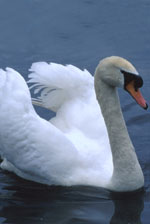Threats to Birds - Mute Swan (Cygnus olor)
Overview
The Mute Swan is native to temperate areas of Europe and western Asia. Because it is a beautiful bird, this species is often kept in captivity to decorate parks and ponds. Mute Swans can be found in the northeastern Atlantic coast and around Lake Michigan in shallow fresh or brackish water, saltwater bays and marshes in winter. In 1962, five captive swans escaped their pen during a storm event and there are now approximately 4,000 Mute Swans in Maryland. In the Chesapeake Bay, Mute Swans are considered a pest species because they compete with native waterfowl for habitat and food which is submerged aquatic vegetation (SAV). By over-grazing Bay grasses, Mute Swans also eliminate habitat for crabs, fish, and other wetland dependent species. They are also aggressive, and in the early 1990s, a large molting flock of Mute Swans caused a colony of Least Tern and Black Skimmer –state-threatened species– to abandon their nesting site on Barron Island by trampling nests containing eggs and chicks.
Description
60" long and can stand 4 feet tall. All-white swan with black legs and feet and an orange bill with black knob at the base, curved neck when floating. Males are larger than females and can weigh 27 lbs. Nest on large mounds that they build in the middle of a shallow lake. Aggressively defends its nest and will attack people who enter its territory. Can breed at 3 years of age, and females lay a clutch of 3 - 8 eggs. Cygnets hatch with a gray downy plumage and they can fly in 3 to 4 months. They generally stay with the parents until the next breeding season. Mute Swans can live for over 25 years, though most live 5 or 6 years.
Birds Affected
Compete with Tundra Swans and other native waterfowl for SAVs; cause shorebirds such as Black Skimmer, Least Tern, Forsters’ Tern, and Common Tern to abandon their nests; known to kill Mallard ducklings and Canada Goose goslings.
Control
Egg addling; live capture and removal of adult swans; euthanasia of adult swans; and shooting by professional hunters. Maryland Department of Natural Resources hopes to reduce the state's population through lethal take of 1000 Mute Swans in 2005.
American Bird Conservancy was closely involved in efforts to remove protection for non-native bird species through passage of the Migratory Bird Treaty Reform Act. Passage of this act in 2004 reversed a previous court ruling that treated some invasive exotic bird species such as the Mute Swan as protected under the Migratory Bird Treaty Reform Act of 1917. |
